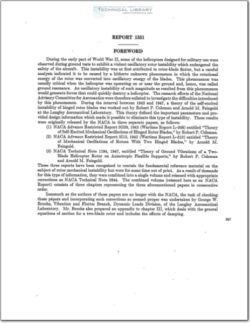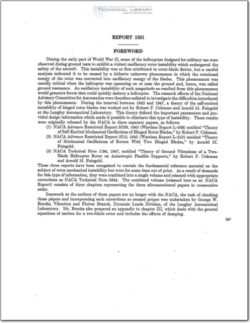NACA-Report-1351

- Version
- 194 Downloads
- 3.62 MB File Size
- 1 File Count
- December 4, 2015 Create Date
- December 4, 2015 Last Updated
National Advisory Committee for Aeronautics, Report - Theory of Self-Excited Mechanical Oscillations of Helicopter Rotors with Hinged Blades

A rotary-wing aircraft that has hinged blades will, under
certain conditions, be subject to vibrations which derive
their energy from the rotation of the rotor instead of from
the air forces. The term “ground resonance” usually refers
to vibrations of this type. Although such vibrations have
apparently caused accidents in some rotary-wing aircraft
and have impaired the flying qualities of others, very little
attention has been given this problem in the literature. A
theoretical analysis has therefore been undertaken, and
the purpose of the present chapter is to present the theory
and to describe the application of the theory to rotary-
wing aircraft.
General vibration theory and its application to allied
problems as well as to the particular problem of, rotor
vibration are discussed in references 1 to 4. A good general
background for the present problem is provided in the chap—
ters on rotating machinery and on self-excited vibrations
in reference 1. References 2 and 3 treat in more abstract
fashion the topics of rotation and damping. A discussion
of the variety of modes of vibration that exist in rotors
and a number of frequency formulas obtained by considering
separately each degree of freedom are given in reference 4.
This discussion does not, However, lead to a prediction of
self-excited modes of vibration.
Experience has shown that two types of mechanical
vibration may occur in rotors“ The vibration frequency of
the pylon is equal to the rotational speed in one type and
is unequal in the other. The first type is sometimes called
the even-frequency vibration or the one-to-one fi‘equency,
and the second type, the odd frequency. The one-to-one
frequency vibration resembles the phenomenon occurring
at a critical speed of the shaft of rotating machinery and
will consequently be referred to in this chapter as a. shaft
critical vibration. The Odd-frequency vibration is properly
called a self-excited vibration.
| File | Action |
|---|---|
| naca-report-1351.pdf | Download |

Comment On This Post